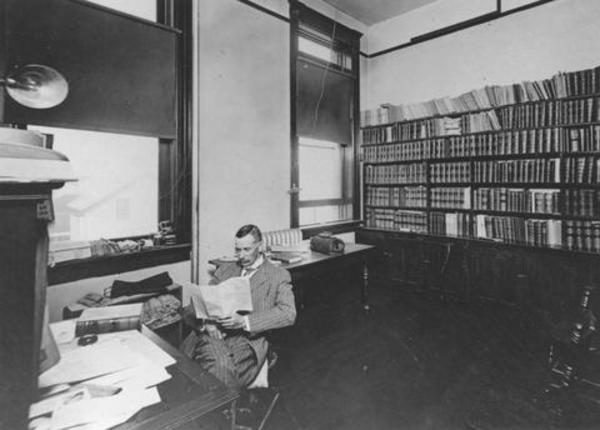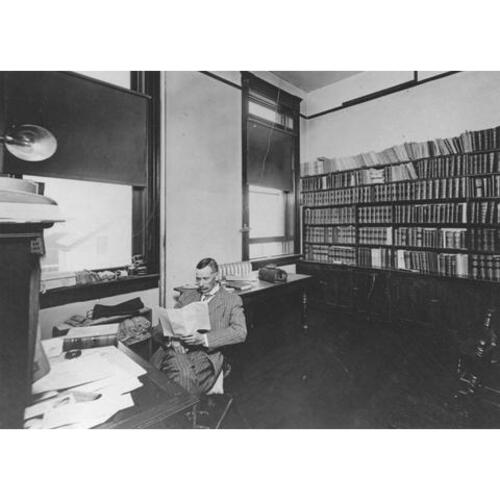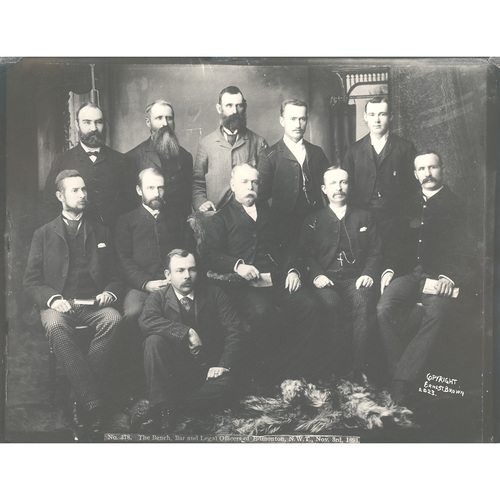
Source: Link
Bown, John Campbell Ferrie, lawyer, author, editor, and university lecturer; b. 17 July 1856 in Brantford, Upper Canada, son of John Young Bown, a physician, and Rachel Campbell Ferrie, daughter of Adam Ferrie* and Rachel Campbell; m. 25 Dec. 1889 Phoebe Miller in Calgary, and they had two children; d. 27 April 1933 in Edmonton.
In later life John Campbell Ferrie Bown would claim that a signatory to the Magna Carta, Henry de Bohun, Earl of Hereford, was his ancestor. Raised in Brantford, Bown joined the militia as a teenager, serving as a private in the Queen’s Own Rifles. In 1879 he graduated with a ba from the University of Toronto. His interest in law stemmed from his father, who had studied the subject before receiving his md in August 1850 from the University of St Andrews in Scotland. After articling in the Brantford office of Wilson and Smyth, the younger Bown was admitted to the bar in 1882 and immediately moved to Winnipeg. His correspondence suggests that his decision may have been motivated by an estrangement from his father, who had married Margaret Macklem Cummings, of mixed Scots–Chippewa blood, after the death of his first wife in 1857. The marriage produced seven children, and he was said to have given no financial assistance to his eldest son following the completion of the latter’s degree. It is possible that Walter Robert Bown*, an uncle who was vice-president and general manager of the North West Trading Company, facilitated his relocation by helping him obtain a position in the legal department of the Canadian Pacific Railway.
Bown went to Calgary in November 1886. Only once in his life (for the Christmas of 1887) did he return to Ontario. Thereafter, he became a devoted man of the west. Struck by the vast prairie framed by the Rocky Mountains, he wrote to friends about the promise of the region and the rich soils of Edmonton. He also preferred the weather. Bown had several well-known acquaintances in Calgary, including Frederick William Gordon Haultain*, Edward Pease Davis, Charles Coursolles McCaul*, and Hugh St Quentin Cayley, all of whom were recent graduates of his alma mater. Admitted as an advocate of the Law Society of the North-West Territories in 1886, he partnered with Henry Bleecker, Calgary’s first town solicitor. Desiring his own law books, he ordered a collection from Toronto’s Carswell and Company in May 1888. His clients were primarily small retailers; his work was debt collection and homestead registrations. “Notes on the Territories Real Property Act,” an article he co-authored with McCaul, appeared in two parts in the February and March issues of the Canadian Law Times (Toronto) of 1889. He married Phoebe Miller on Christmas Day of the same year, and the couple honeymooned in Banff. Diligent and frugal, Bown tried to improve his financial prospects after his marriage by applying for the position of town clerk, but he was denied. In 1890 he helped found the Calgary Bar Association, and he and Cayley set up a partnership. The firm was dissolved soon after, and the following year he moved to Edmonton on one of the first trains to roll into that town.
Though the descendants of his many practices included the two firms Short and Cross and Milner Fenerty, in the 1890s he worked mostly alone in a floundering practice. He failed to obtain agency work for banks and insurance companies, or a position in the local government as town clerk, town solicitor, or judge. Bown did, however, succeed in being named liquor-ordinance prosecutor, in March 1892, and he also became territorial election clerk. He relied on Antonio Prince, a francophone mla who was briefly his partner, to attract French-speaking clients. Through this contact he expanded into criminal-defence cases and set up an agency for the Standard Loan Company of Toronto. Although his finances improved, he continued to complain about the dearth of business, the surfeit of lawyers, and the cost and hardship of chasing clients and judges from township to township for small sums. Yet word of his renown as a criminal lawyer spread with the Yukon gold rush and the accompanying rash of robberies and petty crime that hit its staging post of Edmonton. In 1902 he would defend the American Charles Bertrand Bullock in the celebrated murder trial that ended with the latter’s hanging.
Reputation and prosperity brought new partnerships, positions, and rewards. In 1902 he became the local editor of the Canada Law List, and the following year he published Synopsis of the laws of the North-West Territories. By the next year he and three other lawyers had formed Bown, Dawson, Kennedy, and Hyndman. His civil-law work expanded: he acted as an agent for the Canadian Northern Railway and handled legal paperwork for investments with the Excelsior Life Insurance Company in Winnipeg. In 1907 he was made a kc and was elected a bencher of the new Law Society of Alberta, for which he worked in the areas of education, bar exams, and ethics. He was also appointed Edmonton’s city solicitor in the same year. A studious man, he would become a recognized expert in municipal law throughout Canada within a decade.
By 1911 Bown had retired from private practice to focus on his duties as city solicitor, a difficult job in the first two decades of the province’s existence. He drafted by-laws on licensing, land development, and building codes, and helped engineer them through city council. Additionally, he oversaw the legal aspects of waterworks, land title, road building, and civic employment, as well as all related litigation matters. In a centre that served a wide agricultural area experiencing harsh financial times, Bown frequently acted as a bill collector; he was also a major resource for Edmonton’s police court, where he worked with inexperienced and underpaid crown prosecutors. Frustration with the highly politicized environment of city council would lead him to apply several times after 1915 for judgeships, without success. Satisfaction came instead from his volunteer work with the law society, where he felt he was fully appreciated. He would be its vice-president in 1926 and president, succeeding Charles Frederick Pringle Conybeare*, from 1928 until his death.
On a number of occasions in the 1920s he spoke out against corruption in his profession. Premier John Edward Brownlee*, a barrister himself, tried to persuade the law society to allow an appointee of his choosing to sit in on disciplinary proceedings against its members, but many in the self-governed society objected to what was seen as political interference. When the vote came to the floor in convocation in July 1928, Bown broke the tie by voting for Brownlee’s request. In 1930 he received an honorary lld from the University of Alberta, where he lectured in the faculty of law.
A meticulous and diligent practitioner, Bown revelled in the details of fact finding and legal minutiae. He kept copies of all his notes, as well as correspondence written after 1916, and maintained his practices in a frugal manner; when he reached the end of a letter-book, he would work towards the front again, writing on the backs of the used pages. The extensive files he left give the impression that Bown was a bookworm who spent much of his time reading legal texts. It seems likely that, despite his attempts at securing higher and better-paid positions, his career aspirations were actually quite modest, and the career path he followed suited his attitudes, work habits, and personality. Bown had many outside interests. An Anglican, he was active in various organizations, such as the Scottish Rite, the Oddfellows, the Knights of Pythias, the Edmonton Club, and the Edmonton Liberal-Conservative Association. He passed away after a severe attack of influenza.
John Campbell Ferrie Bown was the editor of Canada Law List (n.p., 1902) and the author of Synopsis of the laws of the North-West Territories (n.p., 1903).
This biography is based on the extensive correspondence and papers in the John C. F. Bown fonds (M 119, M 1923, M 4540, NA 55, NA 295, NA 876, NA 898, NA 989, NA 1296, NA 1912, NA 2411, NA 2651, NA 3439, PA 20, PA 41, PA 58, PA 153, PB 19) at GA. Bown was an avid collector of photographs; the many images of aboriginals and pioneers that he amassed are now held at the Glenbow Museum in Calgary. He himself is thought to be the subject of a photographic portrait at the Legal Arch. Soc. of Alta (Calgary).
Brantford Weekly Expositor (Brantford, Ont.), 3 Oct. 1890. Edmonton Journal, 28 April 1933. J. W. McClung, Law west of the Bay ([Edmonton?], 1997). P. M. Sibenik, “The doorkeepers: the governance of territorial and Alberta lawyers, 1885–1928” (ma thesis, Univ. of Calgary, 1984).
Cite This Article
Louis A. Knafla, “BOWN, JOHN CAMPBELL FERRIE,” in Dictionary of Canadian Biography, vol. 16, University of Toronto/Université Laval, 2003–, accessed December 21, 2025, https://www.biographi.ca/en/bio/bown_john_campbell_ferrie_16E.html.
The citation above shows the format for footnotes and endnotes according to the Chicago manual of style (16th edition). Information to be used in other citation formats:
| Permalink: | https://www.biographi.ca/en/bio/bown_john_campbell_ferrie_16E.html |
| Author of Article: | Louis A. Knafla |
| Title of Article: | BOWN, JOHN CAMPBELL FERRIE |
| Publication Name: | Dictionary of Canadian Biography, vol. 16 |
| Publisher: | University of Toronto/Université Laval |
| Year of publication: | 2016 |
| Year of revision: | 2016 |
| Access Date: | December 21, 2025 |




